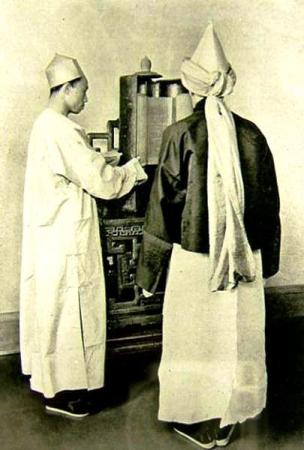
Dating back almost three millennia, the Jewish community in Iran is the oldest in Asia. Originating as enslaved subjects in ancient Babylon (now, Iraq), Jews first settled within the territory of modern-day Iran after the Persian emperor Cyrus conquered Babylon in 539 BCE, freeing the Jewish slaves and making them an integral part of the Persian Empire. As Persian subjects, Jews traveled widely and did business in Persian dominated lands from Afghanistan, the Caucasus and Caspian through Central Asia.
In the Caucasus, the Jews traded with many of the displaced Turkic tribes that were wandering westward and southward, but they formed a special association with the Khazars. Evidence of great glassworks factories can be found in Orbeti, which dates to the 7th and 8th centuries. This factory were likely under Jewish control, because the designs of the glass produced in these factories and especially the shape and the coloration of the beads can be traced to Near-Eastern Jewish glass designs. Around this time the Khazar king “converted” to Judaism and by the 8th and the 9th Centuries, most Khazars followed Judaism as they continued west and south into the Danube basin.
The largest settlements of Persian Jews in Central Asia was to be found in Uzbekistan, and Jewish merchants worked the important hubs of commerce along the Central Asian Silk Road in places like Bukhara and Samarkand, helping to establish them as major trading posts.
Mediterranean Jews were great entrepreneurs who controlled a considerable part of the trade in that region and played an important role in developing the economies of those nations. In Alexandria, they monopolized shipping; in Syria they controlled many of the markets and as early as the first few centuries AD, they set up their own silk production industry based in Beirut. Other arts and crafts that were dominated by Jews in this region were textile dyeing and glassworks – with glass beads often being used to pay for incoming shipments of foreign goods.

So the mixing and blending of goods, foods and cultures in countries touched by the great Asian trade routes was accomplished by a wide variety of different types of people – most of whom were merchants – out to make a buck along the Silk Road. For thousands of years, Arabs, traded with Africans and Greeks and Jews, and Jews traded with Persians, Georgians, Uzbeks and Chinese, and Chinese traded with Indonesians and Thais and Sri Lankans and Arabs who traded with . . . As bloodlines merged, imported cultural practices became integrated into those held dearly for millennia and modern cuisines emerged from the crucible of history – all blended and formed along the Great Silk Road. (Words by Laura Kelley)

This is fascinating having just returned from China.
Have you seen this article on the origins of the Ashkenazic Jews along the Silk Road? It’s arcane, but fascinating. It combines linguistics and geographic genetics to trace the physical and linguistic origins of the Ashkenazim.
https://www.frontiersin.org/articles/10.3389/fgene.2017.00087/full
Hi George:
Thanks for the link, I’ll check it out!
Laura
George, I have just reviewed the interesting chart using DNA analysis to link Ashkenazi Jews (AJs) to the Silk Road and Khazars in greater numbers and with more evidence than the theory of migration north with the Roman armies. So, what this theory holds is intense settlement in Turkey and the Slavic lands in the second half of the first millenium and migration with trade into the three known cities-Worms, Mainz…with such a thriving Jewish culture? But then why would Turkish Jews be considered Sephardic??
Hi Laura what a lovely piece. I am writing my honours on Jewish origins, particularly those of my family who are Ashkenazi Jews. Which literature did you use for your writing? I am fascinated by the image too. Could you please let me know where you found the image as it is really striking and emphasises your text well.
I would be happy to share my research with you .
Hi Julia:
Thank you for your kind words. Unfortunately, I wrote that piece almost 10 years ago and cannot remember my sources. The photo of the Chinese Jews reading the Torah scroll came from a British antique site selling the photo. Beyond that, I’m sorry I cannot help. Good luck! Laura